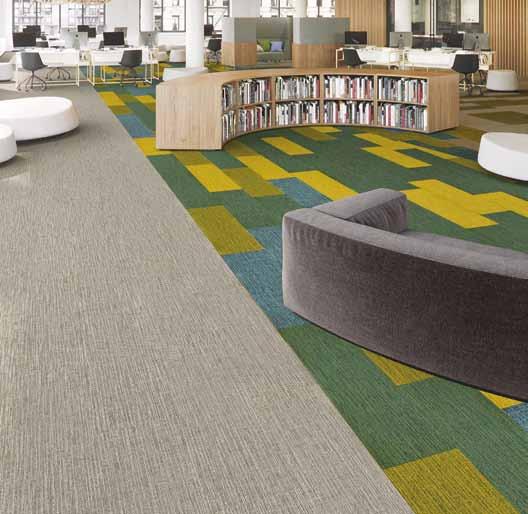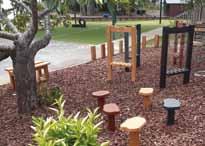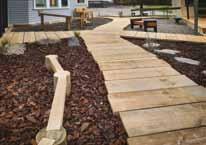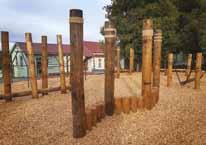
10 minute read
WHAt DID tHe fINAL tOmOrrOW’S ScHOOLS repOrt recOmmeND?
Flooring Solutions for Education Environments.
Creating the right classroom environment is essential for students who need to feel welcome and safe, in a space that reduces the anxiety of being in a new environment – especially for the youngest students and new starters. Classroom design is key for creating a nurturing space to cultivate positive associations with school and learning for young students.
SAFE & HEALTHY
Slips and falls are a leading cause of injury in most public buildings and are especially prevalent in schools. Carpet should be favoured from a safety perspective, softer surfaces mean that any falls may be less severe. Additionally, GH Commercial carpets meet the Carpet Institute of Australia’s Environmental Certification Scheme (ECS) criteria for indoor air quality standards for low VOC emissions.
WELLBEING
Comfort is a pivotal factor in creating a positive learning environment. For teachers who may be on their feet for long periods of time, implementing carpet into classrooms improves underfoot support and prevents muscle fatigue and inflammation. Furthermore, carpet offers children a comfortable area to sit, walk and learn on.



SOUND ABSORBENT
Managing noise levels in the classroom is essential for creating a positive learning environment. Soft flooring has the ability to significantly improve the functionality and sound control of indoor spaces by absorbing and reducing unwanted noise. A high performance carpet can practically eliminate floor general classroom noise.
PRACTICALITY AND DURABILITY
Quality floor coverings that are almost maintenance free and long lasting to save costs in the long run. GH Commercial modular carpet tiles have built-in stain repel technology, which works to prevent liquids from seeping into the carpet fibres. This means spills can be cleaned up easily and no chemicals are required.
SUSTAINABILITY
It’s equally important to think about the environmental impact of the flooring you choose. And if your school has its own sustainability goals, selecting the most environmentally friendly flooring will bring you one step closer to achieving them. GH Commercial offer Red-List Free and Declare certified flooring products, that illustrate our commitment to transparency and healthy interior environments.
AESTHETICS
Clever colour and design choices, particularly in classrooms and libraries, can make the learning space feel more calming, and contribute to a more attentive atmosphere. Use bright patterned carpet tiles to stimulate creativity, or more subtle tones for study areas. Additionally, in large educational spaces – “wayfinding” and zoning with carpet tiles improve efficiency, helping students effortlessly transition from one room to another.
0800 500 210 commercial@godfreyhirst.co.nz ghcommercial.com
Bringing it all togEthEr: thE roadma thE tomorrow’S SchoolS SySt
Dr cathy Wylie chiEF rESEarchEr at nZcEr
2020 should mark the start of a new era for school leadership in Aotearoa New Zealand. We have a long overdue national Leadership centre being established within the teaching council, anchored by the Leadership Strategy launched in 2018. Ongoing, customised support for principals and other school leaders is heralded in the new role of local Leadership Advisors, who are also to support local development of school leadership and sharing of knowledge and experiences.
tHAt’S HOW I started an article that came out in the March 2020 issue of NZ Principal. The optimism had to give way as COVID 19 dominated our attention, and government attention and resources. Not surprisingly, many in education have lost sight of the reinvigorating of our schooling system recommended by the Tomorrow’s Schools Independent Taskforce, and the government’s inclusion of most of our final report’s recommendations in its outline of its subsequent reform programme, Supporting all schools to succeed.i
That reform programme covers support for leaders, teachers, boards of trustees, strengthening school provision, more equitable access to schooling, disability and learning support, improved resourcing and strengthened national education agencies. It can be seen as a road-map, unfolding over years, since this is major reform that it will take more money than can be allocated to schooling in 1, 2 or 3 years of government budgets. Just as crucial as the money, is the development of capabilities and shifts in behaviour and culture throughout the system, so that schooling is a flourishing ecosystem of collective professionalism rather than semi-connected, competing, or mistrusting islands of individual schools and government agencies.
Whiria Ngā Kura Tūātinitini Our Schooling Futures: stronger together final report by the Tomorrow’s Schools Independent Taskforce was made public in November 2019, at the same time as the government’s reform programme.ii This may be why some educators I meet still think of the taskforce’s recommendations as those in its initial report, released late 2018. Consultation on our initial recommendations in early 2019 did lead to some changes in what we finally proposed.
Two clear purposes underpin our final recommendations to support school leadership.iii These provide a useful lens to evaluate the progress of the government’s reform programme: ■ Every school/kura to have a highly effective tumuaki/principal ■ A system that develops leadership at all levels of kura/schools and the schooling system
we made four high level recommendations. These three were included in the government’s reform programme, to be progressed ‘within the next 12-18 months’: ■ A Leadership Centre is established within the Teaching Council of Aotearoa New Zealand ■ The Leadership Centre sets national eligibility criteria for principals/ tumuaki appointment and guidelines for performance review. It should also provide a single set of professional standards for principals/tumuaki, to be used for their performance review. ■ Leadership Advisors employed by the Education Support Learning Network will work collaboratively with each principal/tumuaki in their school/kura. Leadership Advisors will also facilitate the collective contribution of principals/ tumuaki to successful learning across the Education Support Learning Network The fourth recommendation was seen as needing further analysis, to be progressed within the next 2-4 years:
Incentives to attract highly capable principals/tumuaki to work in schools/kura with more complex challenges are broadened.
The national Leadership Centre connected with the local Leadership Advisors who provide tailored support and advice is key to our recommendations around Leadership – in much the same way as our recommendations around curriculum support connect a national Curriculum Centre and local curriculum advisors.
The Leadership Centre’s prime role is to provide the coherent spine to the leadership development and support which we saw happening more at the local level. It was not to provide professional development itself. It would enable consistency (not

roadma Em P to rEForm
uniformity), knowledge-building and sharing, and connection. Leadership Advisors would have a reliable and trustworthy resource, to which they would also contribute.
We were clear that the Leadership Centre should build on recent solid, collective work, rather than lose time and momentum as we so often have in Aotearoa New Zealand through reinvention. So we recommended that the Leadership Centre’s work would be framed by the Teaching Council’s 2018 Leadership Strategy and its Leadership Capabilities Framework.
The Leadership Centre’s role included ■ Providing a repository for leadership research, sharing periodic updates of relevant research with the profession, and commissioning or undertaking new research or evaluation ■ Providing accreditation to those who wished to provide leadership professional learning and development ■ Developing national guidelines for nationally funded sabbaticals and scholarships, and making decisions on their allocation ■ Working with the leadership advisors, principals/tumuaki, leadership networks and peak bodies and the Ministry of
Education to achieve the goals of the workforce strategy (e.g., matching the diversity of the learner/ākonga population and the leadership workforce) The Leadership Advisors we proposed provide the meaningful relationships, connections and support for individual school leaders that we have left to good will, location, individual effort, and luck for too long. They bridge that costly gap between school leaders and the Ministry of Education that has too often eroded mutual respect.
These are different roles than the current advisory or support roles in regional Ministry of Education offices. They are based on in-depth knowledge and understanding of individual school/ kura contexts, able to offer tailored advice and support to develop leadership and timely help to address school or leadership issues as they arise. New principals/tumuaki would be supported with customised induction and ongoing mentoring. Leadership advisors would also ensure that national appointment criteria and performance review guidelines are followed.
We also saw that leadership advisors working together with principals/tumuaki could identify leadership potential, and







provide or broker appropriate professional learning for the area’s potential and existing school leaders. Because of their nodal role, leadership advisors would also feed back effective local leadership practices to the Leadership Centre, so that the whole system can benefit.
where are we now? Last year during lockdown I finished work on NZCER’s report of its 2019 national survey of primary schools.iv The section on principal careers, wellbeing and support makes for sombre reading. Only half the principals felt well prepared for their first principalship. While principals are generally optimistic and enjoy their jobs, there are downward trends over the last decade in principal wellbeing and being able to schedule enough time for the educational leadership part of their role. Too few thought their workload was sustainable, or that they got the support they needed from government agencies. Mutual support of each other was not widespread or deep. Interestingly, 58 per cent would like more career options in education beyond the principal role, pointing to potential we cannot easily tap in our current system, and the artificial ceiling we have made for our school leaders, unlike other national systems.
I thought again about how much we expect of our school leaders. I thought too of how often national strategies and programmes have struggled to make substantial improvements across the board. And I thought of the now substantial research literature on the key role played by well-connected and supported school leaders in improving teaching and learning.
The case for considerable change in how leaders are grown and supported has been made, and I believe accepted by government. But the devil lies in the detail, which is yet to be made clear. I am concerned that the recent proposed high level design for the Education Service Agency does not specifically mention the crucial role of Leadership Advisors within the functions of the Regional Delivery Groups. And I am concerned that there is no clear roadmap for the development of the Leadership Centre to instill confidence that it too can play its vital anchoring role.
refereNceS
i Ministry of Education. (2019). Supporting all schools to succeed.
Reform of the Tomorrow’s Schools system. Wellington: Ministry of
Education. https://conversation.education.govt.nz/assets/TSR/
November-2019/TSR-Government-Response-WEB.pdf
Appendix 2, p 38 -49 shows the Taskforce’s final recommendations, and the government’s response. ii Tomorrow’s Schools Independent Taskforce. (2019). Our schooling futures: stronger together Whiria Ngā Kura Tūātinitini
Final report. Wellington: Ministry of Education. https:// conversation-space.s3-ap-southeast2.amazonaws.com/
Tomorrows+Schools+FINAL+Report_WEB.pdf iii Our section on Supporting School Leadership is pp. 32 to 37 of our final report. iv Wylie, C. & MacDonald, J. (2020). What’s happening in our
English-medium primary schools. Findings from the NZCER national survey 2019. NZCER. https://www.nzcer.org.nz/research/publications/what-shappening-our-english-medium-primary-schools-findingsnzcer-national-0





BEFORE-SCHOOL CARE AFTER-SCHOOL CARE HOLIDAY PROGRAMMES
Is it time for a change?
THE LARGEST
NZ OWNED
OUT-OF-SCHOOL CARE PROVIDER
Affiliated with
Why have over 60 schools in New Zealand chosen Kelly Club?
Revenue-share model. Not just a hall renter. We share revenue with your school. Quality care you can trust. Our programmes are approved by the MSD and our nutritious, yummy food complies with the Food Act 2014.
Childcare subsidies. Caregivers can access WINZ subsidies to help cover their costs. Parents love our flexible bookings. Our same-day booking and cancellation without penalty, means caregivers only pay for the childcare they use. We make out-of-school care easy and hassle-free
Contact Paul Jamieson | paul@kellyclub.co.nz | 021 409 241 | join.kellyclub.co.nz





